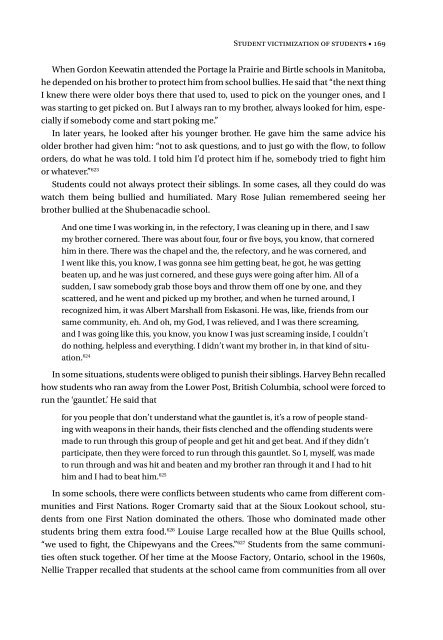The Survivors Speak
1MB8J05
1MB8J05
Create successful ePaper yourself
Turn your PDF publications into a flip-book with our unique Google optimized e-Paper software.
Student victimization of students • 169<br />
When Gordon Keewatin attended the Portage la Prairie and Birtle schools in Manitoba,<br />
he depended on his brother to protect him from school bullies. He said that “the next thing<br />
I knew there were older boys there that used to, used to pick on the younger ones, and I<br />
was starting to get picked on. But I always ran to my brother, always looked for him, especially<br />
if somebody come and start poking me.”<br />
In later years, he looked after his younger brother. He gave him the same advice his<br />
older brother had given him: “not to ask questions, and to just go with the flow, to follow<br />
orders, do what he was told. I told him I’d protect him if he, somebody tried to fight him<br />
or whatever.” 623<br />
Students could not always protect their siblings. In some cases, all they could do was<br />
watch them being bullied and humiliated. Mary Rose Julian remembered seeing her<br />
brother bullied at the Shubenacadie school.<br />
And one time I was working in, in the refectory, I was cleaning up in there, and I saw<br />
my brother cornered. <strong>The</strong>re was about four, four or five boys, you know, that cornered<br />
him in there. <strong>The</strong>re was the chapel and the, the refectory, and he was cornered, and<br />
I went like this, you know, I was gonna see him getting beat, he got, he was getting<br />
beaten up, and he was just cornered, and these guys were going after him. All of a<br />
sudden, I saw somebody grab those boys and throw them off one by one, and they<br />
scattered, and he went and picked up my brother, and when he turned around, I<br />
recognized him, it was Albert Marshall from Eskasoni. He was, like, friends from our<br />
same community, eh. And oh, my God, I was relieved, and I was there screaming,<br />
and I was going like this, you know, you know I was just screaming inside, I couldn’t<br />
do nothing, helpless and everything. I didn’t want my brother in, in that kind of situation.<br />
624<br />
In some situations, students were obliged to punish their siblings. Harvey Behn recalled<br />
how students who ran away from the Lower Post, British Columbia, school were forced to<br />
run the ‘gauntlet.’ He said that<br />
for you people that don’t understand what the gauntlet is, it’s a row of people standing<br />
with weapons in their hands, their fists clenched and the offending students were<br />
made to run through this group of people and get hit and get beat. And if they didn’t<br />
participate, then they were forced to run through this gauntlet. So I, myself, was made<br />
to run through and was hit and beaten and my brother ran through it and I had to hit<br />
him and I had to beat him. 625<br />
In some schools, there were conflicts between students who came from different communities<br />
and First Nations. Roger Cromarty said that at the Sioux Lookout school, students<br />
from one First Nation dominated the others. Those who dominated made other<br />
students bring them extra food. 626 Louise Large recalled how at the Blue Quills school,<br />
“we used to fight, the Chipewyans and the Crees.” 627 Students from the same communities<br />
often stuck together. Of her time at the Moose Factory, Ontario, school in the 1960s,<br />
Nellie Trapper recalled that students at the school came from communities from all over


